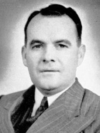
The Australian Labor Party (ALP), also simply known as Labor, is the major centre-left political party in Australia, one of two major parties in Australian politics, along with the centre-right Liberal Party of Australia. After serving as Opposition in the federal parliament since the 2013 election, the Labor Party was returned to government in the 2022 election. The ALP is a federal party, with political branches in each state and territory. They are currently in government in Victoria, Queensland, Western Australia, South Australia, the Australian Capital Territory, and the Northern Territory. The Labor Party is the oldest political party in Australia, being established on 8 May 1901 at Parliament House, Melbourne, the meeting place of the first federal Parliament.

Joseph Benedict Chifley was an Australian politician who served as the 16th prime minister of Australia from 1945 to 1949. He held office as the leader of the Australian Labor Party (ALP) from 1945, following the death of John Curtin on 5 July, until his own death in 1951.

Francis Michael Forde was an Australian politician who served as prime minister of Australia from 6 to 13 July 1945. He was the deputy leader of the Australian Labor Party (ALP) from 1932 to 1946. He served as prime minister in a caretaker capacity after the death of John Curtin, and is the shortest-serving prime minister in Australia's history.

The deputy prime minister of Australia is the deputy chief executive and the second highest ranking officer of the government of Australia. The office of deputy prime minister was officially created as a ministerial portfolio in 1968, although the title had been used informally for many years previously. The deputy prime minister is appointed by the governor-general on the advice of the prime minister. When Australia has a Labor government, the deputy leader of the parliamentary party holds the position of deputy prime minister. When Australia has a Coalition government, the Coalition Agreement mandates that all Coalition members support the leader of the Liberal Party becoming prime minister and mandates that the leader of the National Party be selected as deputy prime minister.

The Scullin Ministry (Labor) was the 19th ministry of the Government of Australia. It was led by the country's 9th Prime Minister, James Scullin. The Scullin Ministry succeeded the Third Bruce Ministry, which dissolved on 22 October 1929 following the federal election that took place on 12 October which saw Labor defeat Stanley Bruce's Nationalist–Country Coalition. The ministry was replaced by the First Lyons Ministry on 6 January 1932 following the federal election that took place in December which saw the United Australia Party defeat Labor. As of 2020, it remains the most recent government to have lost an election after a single term in office.
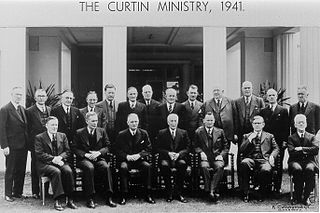
The First Curtin Ministry (Labor) was the 29th ministry of the Government of Australia. It was led by the country's 14th Prime Minister, John Curtin. The First Curtin Ministry succeeded the Fadden Ministry, which dissolved on 7 October 1941 after the independent crossbenchers Alexander Wilson and Arthur Coles withdrew their support for the Fadden Government. The ministry was replaced by the Second Curtin Ministry on 21 September 1943 following the 1943 federal election.
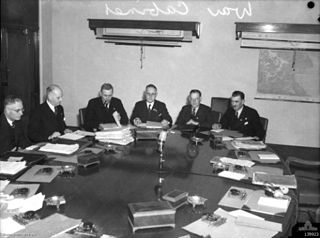
The Second Curtin Ministry (Labor) was the 30th ministry of the Government of Australia. It was led by the country's 14th Prime Minister, John Curtin. The Second Curtin Ministry succeeded the First Curtin Ministry, which dissolved on 21 September 1943 following the federal election that took place in August. The ministry was replaced by the Forde Ministry on 6 July 1945 following the death of Curtin - the second of three occasions where a sitting Prime Minister died in office.

The First Chifley Ministry (Labor) was the 32nd ministry of the Government of Australia. It was led by the country's 16th Prime Minister, Ben Chifley. The First Chifley Ministry succeeded the Forde Ministry, which dissolved on 13 July 1945 following the election of Chifley as Labor leader after the death of former Prime Minister John Curtin. The ministry was replaced by the Second Chifley Ministry on 1 November 1946 following the 1946 federal election.

The Fourth Menzies Ministry was the 34th ministry of the Government of Australia. It was led by the country's 12th Prime Minister, Robert Menzies. The Fourth Menzies Ministry succeeded the Second Chifley Ministry, which dissolved on 19 December 1949 following the federal election that took place on 10 December which saw the Coalition defeat Ben Chifley's Labor Party. The ministry was replaced by the Fifth Menzies Ministry on 11 May 1951 following the 1951 federal election.
The Second Whitlam ministry (Labor) was the 48th ministry of the Government of Australia. It was led by the country's 21st Prime Minister, Gough Whitlam. The Second Whitlam ministry succeeded the first Whitlam ministry, which dissolved on 19 December 1972 after the final results of the federal election that took place on 2 December became known and the full ministry was able to be sworn in. The ministry was replaced by the Third Whitlam ministry on 12 June 1974 following the 1974 federal election.
The first Hawke ministry (Labor) was the 54th ministry of the Government of Australia. It was led by the country's 23rd Prime Minister, Bob Hawke. The first Hawke ministry succeeded the Fourth Fraser ministry, which dissolved on 11 March 1983 following the federal election that took place on 5 March which saw Labor defeat Malcolm Fraser's Liberal–National Coalition. The ministry was replaced by the second Hawke ministry on 13 December 1984 following the 1984 federal election.
The second Hawke ministry (Labor) was the 55th ministry of the Government of Australia. It was led by the country's 23rd Prime Minister, Bob Hawke. The second Hawke ministry succeeded the first Hawke ministry, which dissolved on 13 December 1984 following the federal election that took place on 1 December. The ministry was replaced by the third Hawke ministry on 24 July 1987 following the 1987 federal election.
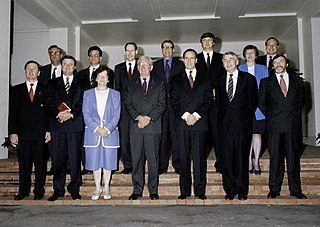
The second Keating ministry (Labor) was the 59th ministry of the Government of Australia. It was led by the country's 24th Prime Minister, Paul Keating. The second Keating ministry succeeded the first Keating ministry, which dissolved on 24 March 1993 following the federal election that took place on 13 March. The ministry was replaced by the first Howard ministry on 11 March 1996 following the federal election that took place on 2 March which saw the Liberal–National Coalition defeat Labor.

The fourth Howard ministry was the 63rd ministry of the Government of Australia. It was led by the country's 25th Prime Minister, John Howard. The fourth Howard ministry succeeded the third Howard ministry, which dissolved on 22 October 2004 following the federal election that took place on 9 October. The ministry was replaced by the first Rudd ministry on 3 December 2007 following the federal election that took place on 24 November which saw Labor defeat the Coalition.
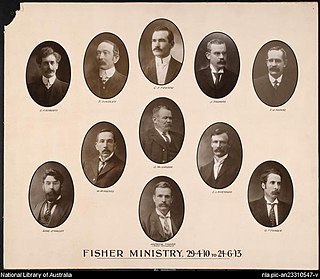
The Second Fisher Ministry was the 8th ministry of the Government of Australia. It was led by the country's 5th Prime Minister, Andrew Fisher. The Second Fisher Ministry succeeded the Third Deakin Ministry, which dissolved on 29 April 1910 following the federal election that took place on 13 April which saw Labor defeat the Alfred Deakin's Commonwealth Liberal Party. It is the first federal government in Australian history to be elected with a majority in the House of Representatives, as well as the first majority national Labor government in the world. The ministry was replaced by the Cook Ministry on 24 June 1913 following the federal election that took place in May which saw the Liberals defeat Labor.

The 1949 Australian federal election was held in Australia on 10 December 1949. All 121 seats in the House of Representatives and 42 of the 60 seats in the Senate were up for election. The incumbent Labor Party, led by Prime Minister Ben Chifley, was defeated by the opposition Liberal–Country coalition under Robert Menzies. Menzies became prime minister for a second time, his first period having ended in 1941. This election marked the end of the 8-year Curtin-Chifley Labor Government that had been in power since 1941 and started the 23-year Liberal/Country Coalition Government. This was the first time the Liberal party won government at the federal level.

The 1946 Australian federal election was held in Australia on 28 September 1946. All 74 seats in the House of Representatives and 19 of the 36 seats in the Senate were up for election. The incumbent Labor Party led by Prime Minister Ben Chifley defeated the opposition Liberal–Country coalition, led by Robert Menzies. It was the Liberal Party's first federal election since its creation. This was the first time the Labor party had won a second consecutive election. This was also the last time the Labor party would win a federal election until the 1972 election.

Edham Nurredin Husic, commonly known as Ed Husic, is an Australian politician serving as Minister for Industry and Science since 2022. Husic is a member of the Australian House of Representatives, elected to represent the seat of Chifley in western Sydney for the Australian Labor Party at the 2010 federal election. He is the first Muslim to be elected to federal parliament, as well as the first Muslim to be made a Minister in the Australian Government.

The Chifley government was the federal executive government of Australia led by Prime Minister Ben Chifley. It was made up of members of the Australian Labor Party in the Australian Parliament from 1945 to 1949.

The Curtin government was the federal executive government of Australia led by Prime Minister John Curtin. It was made up of members of the Australian Labor Party in the Australian Parliament from 1941 to 1945.



















